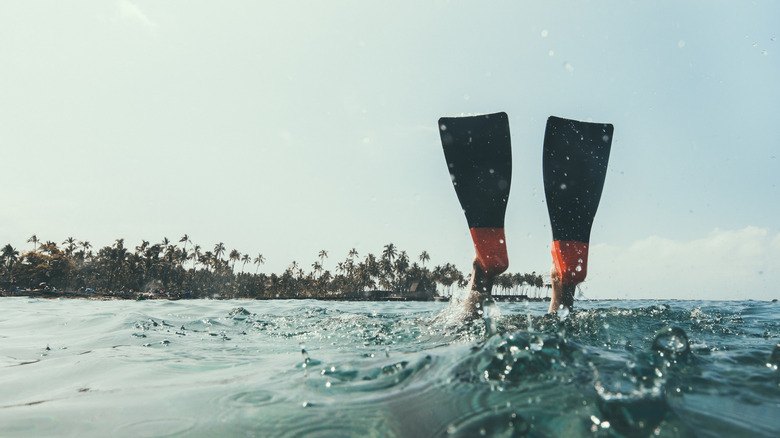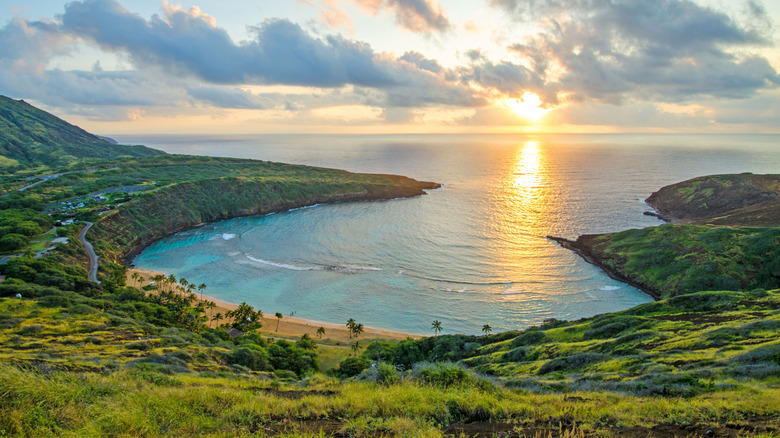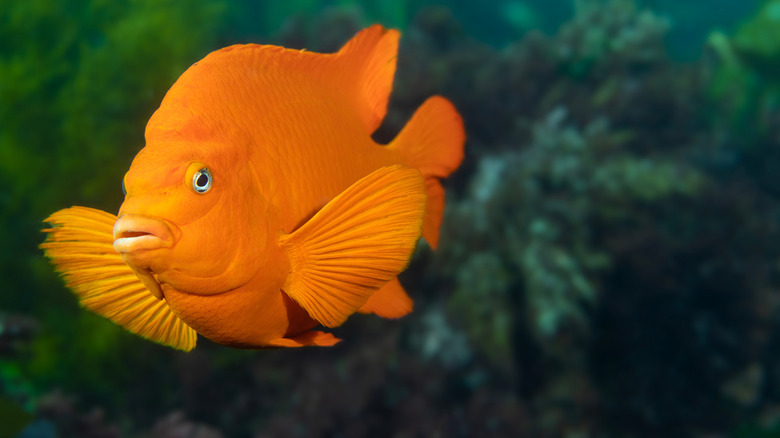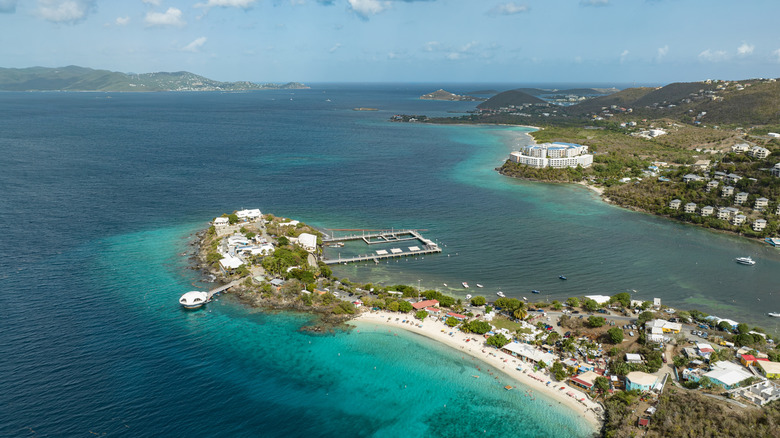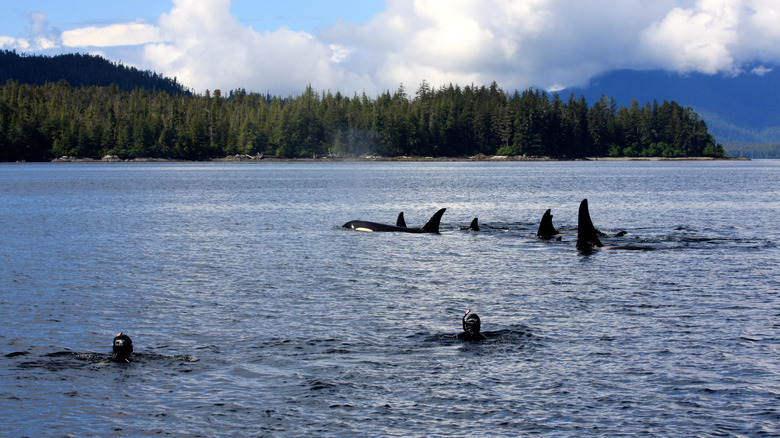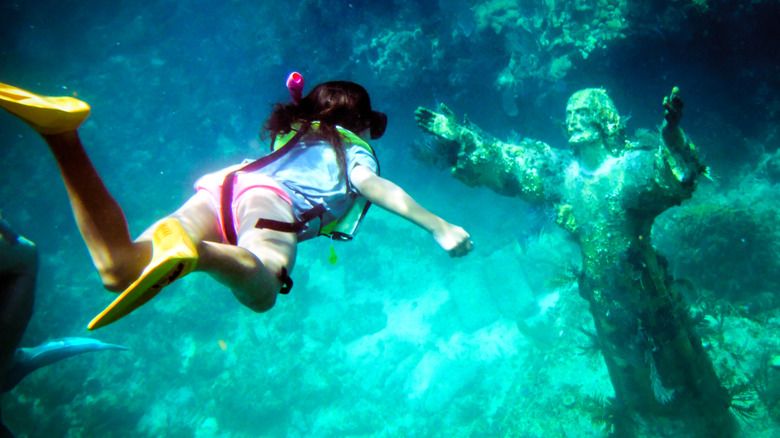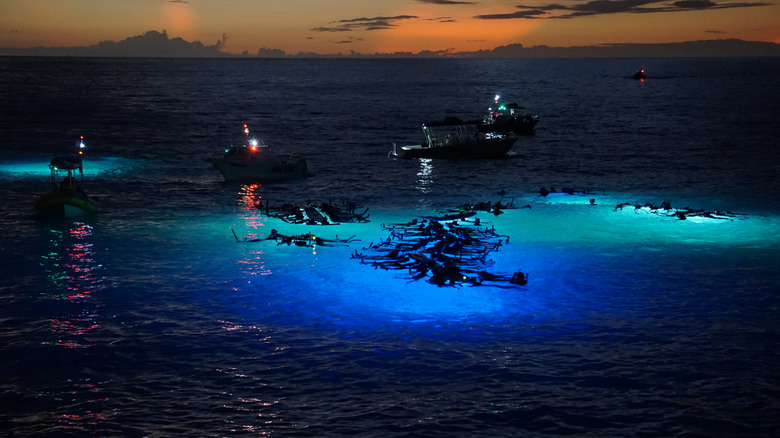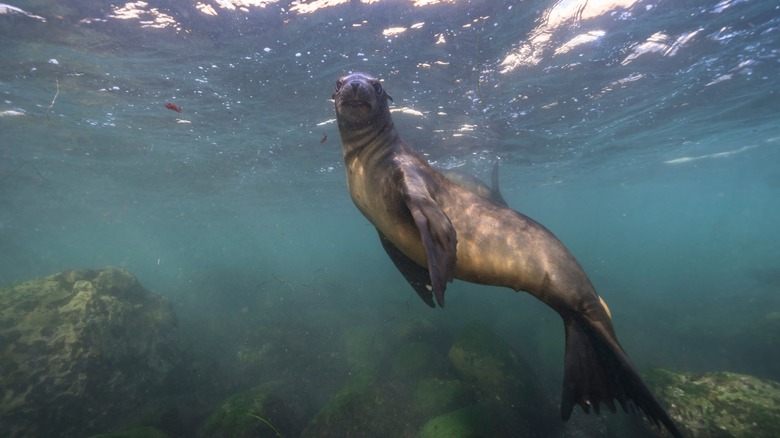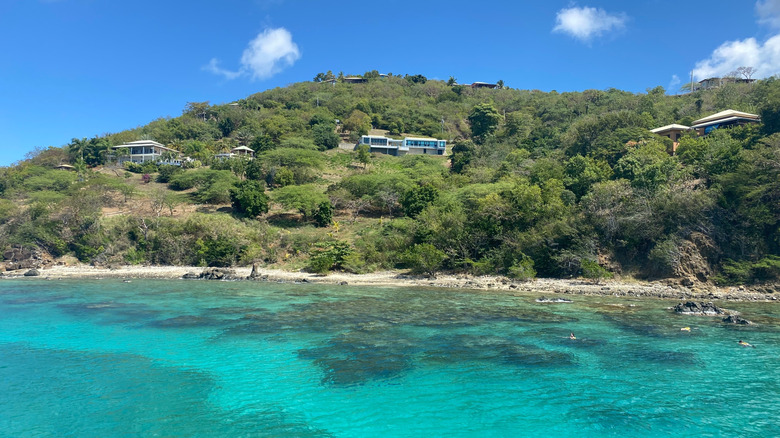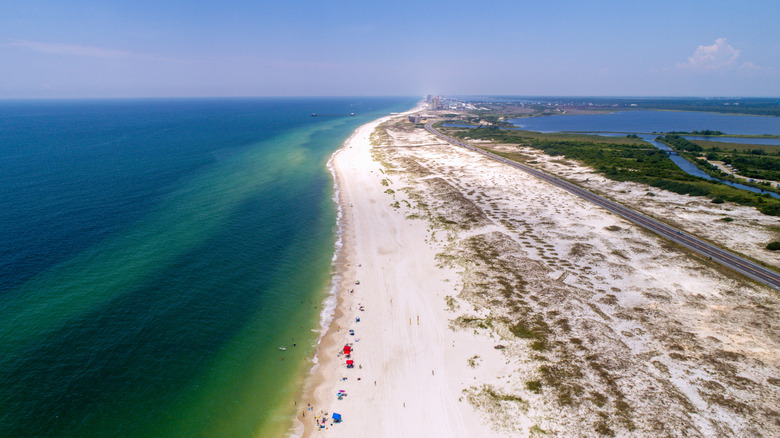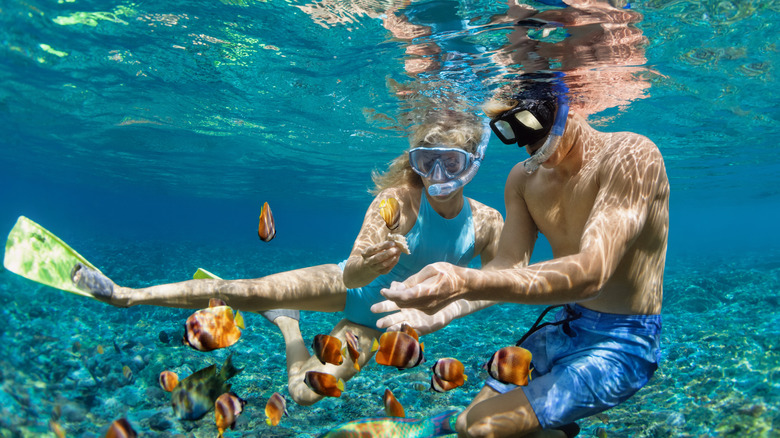10 Best Snorkeling Locations In The U.S. For Both Beginners And Pros, According To Research
Snorkeling is one of the best ways to experience the natural beauty of the ocean and observe the amazing creatures that call it home. As long as you can swim, there's not much to it. All you need is a snorkel, mask, and maybe a pair of fins to help you float while you admire the underwater world — and if you live in the U.S., you might even be able to get started nearby.
From the Caribbean to the Pacific, the U.S. has many incredible snorkeling sites where you can experience a variety of marine ecosystems, from coral reefs to kelp forests. Every spot offers something unique to appreciate, and there are plenty of options depending on your skill level. Beginners can see just as much as experts in calm, shallow waters. Meanwhile, advanced snorkelers can explore new frontiers, like the icy seas of Alaska, or swim with more intimidating, but ultimately friendly, marine life like leopard sharks.
In a country full of epic nature, you're missing half the story if you don't get out and snorkel. Here are the 10 best snorkeling locations in the U.S., whether you're trying snorkeling for the first time or looking for your next big adrenaline rush.
Dry Tortugas National Park, Florida
At the very bottom of Florida, this Dry Tortugas National Park lies 70 miles west of Key West, and is only accessible by boat or seaplane. The park is centered around Fort Jefferson, but you'd be missing the whole point of traveling here if you didn't get in the water. Over 60,000 acres of coral reefs — home to countless tropical fish and five species of sea turtle – thrive in the park, allowing snorkelers to revel in the colorful spectacle of marine life.
The most popular snorkeling spots are along the Moat Wall, where you can also look for historic artifacts like anchor chains. There are many coral reefs around the area that you can visit by booking a day trip out of Key West – the southernmost point in the continental U.S. – on a boat that will take you around the park's various snorkeling sites. It's one of the most popular activities in Dry Tortugas, but visitors should be aware that there are strict rules in place to protect the fragile environment, such as avoiding stepping on or touching corals and not collecting shells. If you want to spend more time in the park, there is a campground at Garden Key, which you can reach via the Yankee Freedom ferry.
Hanauma Bay Nature Preserve, Hawaii
Although Florida is a close contender, there is probably no state better for snorkeling than Hawaii. The tropical archipelago in the mid-Pacific is a hotspot for marine life you won't see in the continental U.S., like green lionfish and the Hawaiian monk seal. Ask anyone about snorkeling spots, though, and there's one site that stands out above the rest — conveniently located just 12 miles away from Honolulu Airport. Oahu's only dedicated snorkeling beach is Hanuama Bay Nature Preserve, a renowned paradise perfect for beginner snorkelers.
Not only can you see over 400 species of fish and occasionally a sea turtle, but the waters are calm and shallow along a wide sandy beach. Although out-of-state visitors need to book their visit in advance and pay an entry fee to access the preserve between 6:45 a.m. and 1:30 p.m., it's an ideal spot to try snorkeling for the first time. Your visit will begin with a briefing video that explains the rules of the reef and some snorkeling best practices. Equipment rentals are available on-site, and if you ultimately decide snorkeling isn't for you, you can still spend the day relaxing on a stunning Hawaiian beach.
Catalina Island, California
Located 22 miles off the coast of Los Angeles, Catalina Island is one of the most unique destinations in California, and it's perfect for snorkeling. The waters surrounding the island are not quite as warm and tropical as Hawaii and Florida, but the beautiful kelp forests are why it's considered one of the best snorkeling and scuba destinations in America.
To get there, ferries are available from Long Beach, Dana Point, and San Pedro. You'll be dropped in Avalon, the island's main town, and can snorkel straight off the Casino Point Dive Park. Lauded by the famous oceanographer Jacques Cousteau, this park is suitable for snorkelers of all levels and a great place to get your bearings before heading to Lovers Cove, famous for its orange garibaldi fish and the occasional sea lion. If you've already got some snorkeling experience, you can book a boat tour with a local dive shop that will guide you to deeper spots. Make sure you ask to see those mesmerizing kelp forests, a natural phenomenon you'll be hard-pressed to find in more tropical destinations.
Coki Beach, U.S. Virgin Islands
Coki Beach on St. Thomas is one of the most popular destinations in the U.S. Virgin Islands. At first, it seems like a party destination lined with bars and restaurants, but strap on your snorkel and you'll soon realize that it's one of the best places to observe the island's colorful marine life. You'll see the coral within the first few moments of wading into the crystal clear, turquoise waters. As you venture further out, there will be plenty of parrotfish, angelfish, and you may spot stingrays and sea turtles as well. The water is calm, so beginners can really relax here, and if you're traveling with non-snorkelers, they will find plenty to do back on shore with shops and restaurants nearby.
While the snorkeling is truly amazing and Coki Beach is worth visiting, it does get crowded. Take advantage of your time in the U.S. Virgin Islands and make sure to visit other nearby snorkel sites, like around the mangroves of Cas Cay, which you can explore on a guided tour.
Mountain Point, Alaska
Tropical waters usually get all the attention from snorkelers, but you'd be surprised by what you may encounter if you took a trip up north. In Alaska, cold-water snorkeling is becoming more popular, with many snorkelers heading to Mountain Point, located near Ketchikan, a small town on Revillagigedo Island. The 65-degree-Fahrenheit waters have good visibility and are home to colorful fish, whales, sea urchins, crabs, and kelp forests. It's a distinct underwater landscape that offers challenges for intermediate snorkelers who can play it safe in the tidepools and for experts who want to freedive along the rock walls.
Snorkel Alaska is the only tour company in town that offers round-trip transportation to the site, gear rentals, and hot showers and beverages to help you warm up afterward. It's not recommended that you go alone if you're unfamiliar with the area. Since Ketchikan is a popular cruise ship port, this excursion may be available to book during an Alaskan cruise. It's a fantastic trip for experienced snorkelers who are curious about different marine ecosystems, but note that cold-water conditions are more physically demanding. According to the tour company's website, participants should be fit enough to walk a mile to the site and be generally in good health.
John Pennecamp State Park, Florida
John Pennekamp Coral Reef State Park, located off the coast of Key Largo, was the United States' first underwater park. Protecting part of the Florida Reef, it is one of the best places for snorkelers to see coral, sea fans, and a very unique statue. "Christ of the Abyss," a nine-foot-tall statue of Jesus, was submerged in 1965 and is now one of most photographed underwater sites in the country. You can book a snorkeling tour to visit the statue through the park's visitor center. There is even a wheelchair-friendly ship that makes the experience accessible for travelers with disabilities.
You can also skip the tour and rent snorkel equipment at Cannon Beach, which does not have a coral reef, but features an old cannon from a Spanish shipwreck and other maritime artifacts to look out for. Some snorkelers also opt to bypass park's visitor center and book a tour departing from Key Largo.
Kona Coast, Hawaii
Hawaii is made up of over 100 islands, so naturally, there are plenty of top-notch snorkeling sites. On the Big Island, the Kona Coast is an ideal place to pop on your fins and jump into the water with your snorkel. The volcanic coastline is protected from the trade winds, which means the sea is calm and perfectly clear. Kealakekua Bay, in particular, is a marine sanctuary and one of Hawaii's top snorkeling spots.
While you will see plenty of corals and fish, the Kona Coast experience you shouldn't miss is the chance to swim with the manta rays at night. These gentle giants are commonly found off the coast, and tour companies will take you out on the water in the evening to snorkel among the majestic creatures at Manta Point. It's an unforgettable trip that will leave you awestruck by the rays' 12-foot wingspans and graceful movements. They do have large mouths, but, as filter feeders, they feed primarily on plankton, so you'll be very safe. If you're new to snorkeling, you may want to take some time to practice in deeper water before swimming with the mantas.
La Jolla Cove, San Diego
You don't need to take a ferry all the way to Catalina Island to enjoy snorkeling in California; you could also head to San Diego. La Jolla Cove, a protected ecological reserve, is one of the best snorkeling locations in the country. The shallow waters are home to sea lions, garibaldi, and leopard sharks, making it one of the few places in the world where you can safely snorkel near these amazing creatures. Not to mention, La Jolla Cove is so beautiful that it's one of the most photographed beaches in California, impressive in a state known for its many gorgeous shores.
The cove is small and calm, which makes it ideal for beginners, and the water is very clear. It is well-known, so if it feels too crowded, you can drive to nearby sites like Seven Seas Cave – although strong swimming skills are required. The best part of La Jolla Cove is that it's only 13 miles from downtown San Diego, so you can mix a bit of snorkeling with a city break.
Flamenco Beach, Puerto Rico
Ranked frequently on lists of the world's most beautiful shorelines, you can find Flamenco Beach on the small island of Culebra, 20 miles east of Puerto Rico. With calm, crystal-clear waters and soft pink-tinted sand, it's the ideal beach, but for snorkelers, the excitement begins where the sand ends. Walk towards the rocks and you will find the reef area known as "Shark Cages." There may be small sharks swimming about, but you will mostly see rays and sea turtles. It can be a slightly challenging spot for weaker swimmers because entry requires navigating between sections of rock and concrete, and the water gets deep in places.
To visit this beach, you can take a short half-hour flight from San Juan to Culebra via Air Flamenco, or take the 90-minute ferry from Ceiba. Alternatively, you could book a day trip from San Juan or Fajardo, which will take you around Culebra by boat or catamaran.
Gulf Shores, Alabama
Alabama probably doesn't spring to mind when you think of snorkeling vacations, but Gulf Shores will surprise you. In these warm waters, you can spot many of the species found around the Caribbean and Florida, like stingrays, octopuses, and sea turtles. Although a lot of the reefs here are artificial, the fish and sea life they attract are not. In Orange Beach, there are three reefs that you can access from various points, such as the Gulf State Park Pavilion. There is also a shipwreck located off a sandbar, sitting at a shallow enough depth that snorkelers can get a good look at it. The Whiskey Wreck is about 450 feet south of the beach near Bahama Bob's Cafe.
A lot of the snorkeling is done off the beach, and the water clarity can be inconsistent, so there aren't many options if you're looking for a guided tour. However, Down Under Dive Shop organizes snorkeling trips and rents gear from their outpost in Orange Beach. They'll take you out with the scuba divers, so you can explore the reefs from the surface.
Methodology
To come up with a comprehensive list that highlights some of the best snorkeling destinations in the U.S., we compared snorkel site rankings across various websites and combed through multiple reviews posted on forums and travel blogs. Some states have the upper hand when it comes to beautiful dive spots, such as Florida, Hawaii, and the U.S. territories in the Caribbean like Puerto Rico and the U.S. Virgin Islands. However we felt it was important to also highlight more unusual, unexpected places where you can snorkel and still see something interesting, whether that be marine life or a shipwreck. We also looked at the water conditions, considering temperature, current, depth, and accessibility, to highlight a wide range of snorkeling spots suitable for all levels, from first-timers to deep-diving experts and adventurous thrill-seekers.
